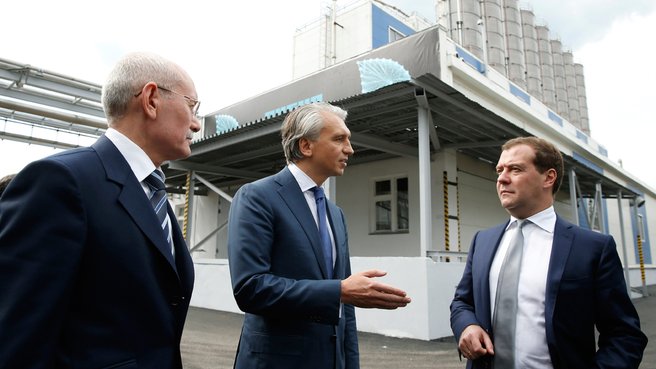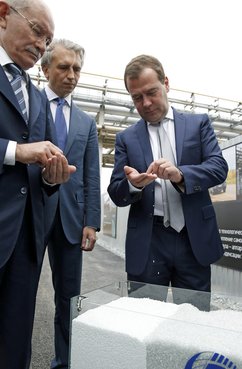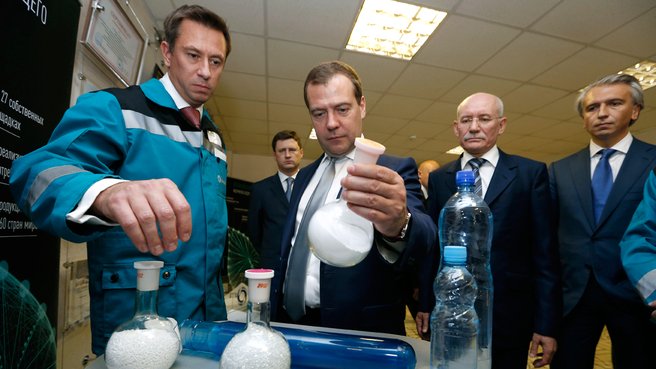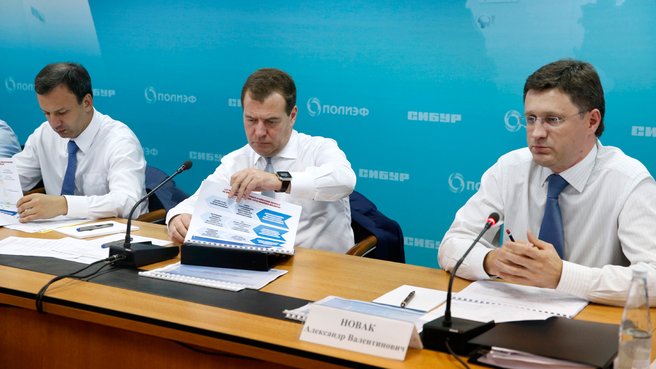Discussion on the chemical industry development strategy up to 2030: supplying the sector with raw materials.
With President of the Republic of Bashkortostan Rustem Khamitov and General Director of Gazprom Neft Alexander Dyukov
Before the meeting, Prime Minister Dmitry Medvedev visited the chemical company Polief, a subsidiary of SIBUR-PETF.
The Prime Minister inspected the company’s production facilities and products.
Polief specialises in the production of terephthalic acid and polyethylene terephthalate, a synthetic linear thermoplastic polymer that is widely used to manufacture carbonated water packaging, baby food, medicines, and household chemicals.
* * *
Transcript:
Dmitry Medvedev: Good afternoon, colleagues. We agreed to hold a meeting on the chemical and petrochemical industry and chose an appropriate location. Polief joint stock company is carrying out some fairly major investment projects to produce modern products with substantial added value. That is what polyethylene terephthalate is. We will discuss investments and some other issues during the meeting.
I would like to start by saying that the chemical and petrochemical industries remain important segments of our national economy. Almost all industries use their products, including the transport industry, agriculture, the defence industry, naturally, the fuel and energy sector, as well and trade and services. That said, despite decent growth (even in the current economic environment, growth was about 3.5% as of May), high-technology products make up no more than 10% of exports. These are mainly low- and medium-conversion products, such as fertilisers and synthetic rubbers. The line of imported products, on the contrary, is very diverse and traditionally features low-tonnage chemical products, such as plastics, varnishes, paints and dyes. That is, we, just like in other industries, sell raw materials and buy finished products, which are often made from our own raw materials. The reasons are well known: obsolete equipment, a poor research and technical base, uncompetitive Russian-made machines, infrastructure constraints related primarily to the transport of oil and gas raw materials and the overall organisational complexity of this industry. This situation has to be changed, and the prerequisites are in place. I will list them for you.
The first is an excess of relatively cheap (I emphasise the term “relatively,” because you may disagree with me on this one) and readily available raw materials.
The second one is a capacious (this one I’m sure of) and fast-growing domestic market. For example, the demand for synthetic resins and plastics is projected to increase on average by about 50% by 2015, chemical fiber and yarn by 120%, and paint products by 130%.
Dmitry Medvedev: "In general, investments in the industry have increased by 50% over the past 18 months to a total of about 225 billion roubles. By 2015, their volume is expected to increase to 330 billion roubles. Notably, 65% is a good indicator and includes corporate equity capital."
Third, the implementation of major long-term projects that are going on across Russia – you are all aware of them – they are located in several Siberian regions and Central Russia. In general, investments in the industry have increased by 50% over the past 18 months to a total of about 225 billion roubles. By 2015, their volume is expected to increase to 330 billion roubles. Notably, 65% is a good indicator and includes corporate equity capital.
Fourth, the availability of vertically integrated companies that can create their own competitive production facilities and promptly respond to changes in the global chemical and petrochemical markets. All major vertically integrated companies are better equipped to cope with certain challenges.
I suggest that we focus today on measures to support domestic producers as part of the Strategy for Developing the Chemical Industry to 2030 and measures to stimulate domestic demand for Russian-made materials, especially in road construction and the construction industry. I’m aware of a number of proposals and I’ve seen the draft minutes, which outline the procedure for simplifying the rules for establishing special economic zones in the chemical and petrochemical industries and a number of other specific proposals. Let's discuss them.
Let’s move on to the substantive issues that I’ve indicated. Let's listen to what our colleagues from Ministry of Energy and the Ministry of Industry have to say, and then we’ll turn it over to corporate delegates. Mr Novak, please go ahead. My only request is that you please keep it short. It says 15 minutes here, but 15 minutes is a lot. Please, try to keep it to 10. Go ahead.
Alexander Novak: Thank you. Mr Medvedev, colleagues. If I may, I will focus only on the part of the petrochemical complex that is overseen by the Ministry of Energy. I will briefly describe the current situation and the challenges faced by the petrochemical industry. In fact, the petrochemical industry engages in processing by-products of the oil and gas industry and oil refining. Products of the petrochemical industry include large-tonnage polymers, synthetic rubbers, organic alcohols, oxides and glycols – that is, raw materials for the chemical industry and other industries and the manufacture of finished products, such as pipes, polymers, packaging, bottles and tyres, to name a few.
The industry boasts a surplus of hydrocarbons at about 25 million tones, accounts for 1.5% of the GDP, and the revenue amounts to about 1 trillion roubles. The amount of investments – 225 billion roubles a year, like you said – has indeed increased by almost 50% in 2012 as compared with 2011. It looks like the surplus of hydrocarbons will stay there for a long time.
According to our forecast, the volume of crude hydrocarbon production will grow from 36 million tonnes to 63 million tonnes. Despite an increase in refining capacities in the forecasted period, we see a crude surplus both today and in the future. And this means we will need to export this excess crude.
Dmitry Medvedev: The only question is what the actual cost of this crude will be.
Alexander Novak: I think this is a good thing, because it is the result of the earlier decisions, including the decision regarding the strict provision to reach 95% utilisation of accompanying gas beginning January 1, 2015. These decisions were taken as part of agreements on upgrading refineries. Generally, this has to do with our plans for oil and gas production according to our forecasts.
Another question (I will elaborate on it later): what should we do about refining capacities and stimulating domestic demand? Bearing in mind that Russia exports crude for the petrochemical industry, we should understand our challenges abroad. I would mention three key challenges.
Alexander Novak: The industry boasts a surplus of hydrocarbons at about 25 million tones, accounts for 1.5% of the GDP, and the revenue amounts to about 1 trillion roubles. It looks like the surplus of hydrocarbons will stay there for a long time. According to our forecast, the volume of crude hydrocarbon production will grow from 36 million tonnes to 63 million tonnes. Despite an increase in refining capacities in the forecasted period, we see a crude surplus both today and in the future.
The first challenge is exploring non-traditional hydrocarbon sources in North America, I mean shale gas and shale oil. They have lowered prices of crude in the US and affected the competitiveness of the petrochemical industry.
The second challenge is the construction of new refining capacities in the Middle East where oil refining is currently concentrated. In addition, the Middle East subsidises the production of ethane which is a raw material for the petrochemical industry. And currently the Mideast ethane price is about 15% of the price of alternative sources.
And the third challenge is expanding production of petrochemical raw material and products in Asia Pacific countries, including through the use of alternative technologies for producing raw material from coal. These factors build up supply of cheap raw materials on foreign markets. If consumption grows to 50 million tonnes by 2020, we expect that the production will grow by 65 million tonnes, that is, the surplus will increase by some 15 million tonnes. We see that our company will face risks because the export of raw materials strengthens competition, particularly price competition. There are risks of decreasing margins and proceeds from exports because we will have to compete against other large suppliers.
Regarding domestic challenges, currently the most important challenge is the shortage of refining capacity, given the large volumes of raw materials. This shortage leads to growing exports, as I have said. Meanwhile – and this is very important – we also see the imports of petrochemical products. Despite the fact that domestic demand is growing…
Dmitry Medvedev: Mr Novak, I have mentioned this – that our imports are large. There’s no need to repeat it. Please, make your proposals.
Alexander Novak: Please, turn to slide four. It shows the situation in the sector as an hourglass, to illustrate the structural problem in the petrochemical industry. A large amount of raw material, about 36 million tonnes, is held up by the narrow bottleneck of the petrochemical industry’s capacities (with pyrolysis capacity standing at 3 million tonnes), which are unable to meet growing demand. Demand is the foundation, the basis of those hours, and as we can see, current demand is at 5 million tonnes while the output is just 3.6 million, for a deficit of 1.4 million tonnes that have to be covered with the help of imports. By 2030, the goal is to widen the bottleneck so as to ensure adequate processing, to increase production capacities and to raise the output of heavy polymers. That said, forecasts envisage a surplus in the consumption of heavy polymers, which should either be exported or should be sold off by stimulating demand on the domestic market. It’s paramount that the construction of industrial petrochemical sites is now outpacing the growth of domestic consumption.
Mr Medvedev, in February 2012 we adopted a programme of measures to develop the gas and petrochemical industry through 2030. This strategy was approved by the Government Commission on the Fuel and Energy Complex. Under this programme, we expect a doubling of the share of gas and petrochemical raw material processed by petrochemical plants, along with a 4.5-fold increase in the aggregate capacity of pyrolysis facilities by 2030. The average per-capita consumption of heavy plastics and resins is expected to grow by a factor of 3.4 and 2.6, respectively. With its current GDP per capita, Russia, in my view, is seriously lagging behind in the consumption of heavy plastics and finished products. The dotted line in Fig. 6 shows the situation in other countries, which consume 1.5-3 times as much plastic as we do at the moment.
Our main priorities include increasing the consumption of raw material for the gas and petrochemical industry to 37 million tonnes, from the current 9.7 million, and increasing the processing depth of petrochemical raw material by a factor of 1.5-2 by the year 2030. This will enable us to reduce the export of petrochemical raw material while also increasing the output of petrochemical products with a higher added value. To meet these targets, we’ll be using a cluster approach. Fig. 8 shows six gas and petrochemical clusters. By and large, all the clusters are provided with raw material, and we can see that from 26 million tonnes in 2012… In 2030, we’re likely to have nearly the same surplus in providing petrochemical clusters with raw material – the surplus is here to stay.
Alexander Novak: "Importantly, by the year 2017 we will have stopped importing polyethylene, and will be faced with a surplus on the domestic market and a need to export or stimulate domestic consumption of chemical industry products."
Speaking of the gas and petrochemical industry’s finished products, Fig. 9 shows some of the major polyethylene production sites, with launch deadlines. The aggregate output is to grow by 5.9 million tonnes in 2020. Importantly, by the year 2017 we will have stopped importing polyethylene, and will be faced with a surplus on the domestic market and a need to export or stimulate domestic consumption of chemical industry products.
The situation with polypropylene is similar. The only difference is that we will become exporters as early as 2014, because of higher production capacities. We’ll have our imports suspended from 2014 through 2017, and will be working to increase the plants’ processing depth and capacity. The export of finished products grows slowly, and so, too, does domestic consumption. Our estimates for the subsequent growth in proceeds shows that the added value will reach its maximum for finished products, such as synthetic fibres and cloths – from 200% to 533% and 947%.
So, our main reserve in encouraging domestic demand for petrochemical products is the suspension of imports, which currently stand at 1 million tonnes per year. This is a large amount. We believe our domestic industry can produce most of the titles on its own. I’m referring primarily to mechanical engineering products, including car parts, face bars, and items for cabin decoration – as well as construction and decoration polymers, furniture, children’s merchandise, products for the medical industry, the power sector and others.
Dmitry Medvedev: Please give us your suggestions, Mr Novak. What should be done do you think to translate all these bright plans into reality?
Alexander Novak: The implementation of this programme, to be run by the Energy Ministry through 2030, is just part of the solution to a systemic problem, involving other bits in the consumer goods production chain.
Dmitry Medvedev: OK. But what are you suggesting?
Alexander Novak: We are proposing further stimulation of the domestic market. We have several proposals on measures to incentivise demand for domestically-produced gas and petrochemical products on the domestic market as well as for deep-processing products on foreign markets.
There’s a separate proposal related to the Ministry of Natural Resources – developing a programme for separate waste collection and polymer recycling, and submitting this document to the Government for approval. Recycling is on the rise in Europe these days. [Here, in Russia,] various kinds of domestic waste are collected all together. But with separated collection, we could immediately send plastics off for recycling.
Also, to ensure plastic packaging safety for consumers, we propose that the Health Ministry develop related technical regulations for materials that come into contact with food and impose a ban on the use of recycled terephthalate film in food packaging. This will increase the demand for previously unused terephthalate, encouraging sales of finished products
We also suggest that the Ministry of Economic Development consider amending customs legislation. We’re talking about easing customs clearance regulations for multiple-use packaging, which will enable its full-fledged circulation in and outside Russia without unnecessary restrictions.
Along with incentives for the domestic market, we suggest that the Energy Ministry and other federal government agencies prepare proposals for improving the tax and customs duty policy in hydrocarbon processing in the longer term, with the ultimate goal being to encourage investment and level out profits in the sector’s various parts. That’s all I’ve got to say for the moment.
Dmitry Medvedev: Thank you. Let’s hear briefly from the Ministry of Industry on this subject. Mr Slyusar, please go ahead.
Yury Slyusar (Deputy Minister of Industry and Trade): If I may, I’d like to begin with our proposals as well.
Dmitry Medvedev: Good idea.
Yury Slyusar: Our main problem is that we export low-conversion products and import high-conversion ones. We propose sitting down with our colleagues from the Ministry of Energy, people from the industry, and experts, reviewing our imports and, accordingly, drawing up an exhaustive list of what can theoretically be produced domestically. We have been assigned to develop a strategy for the chemical industry until the end of 2013. We suggest going over the list from top to bottom and identifying products that we are importing for the needs of our high-tech industries. We hope that the growth of the aviation and shipbuilding industries, and everything else, will give an additional boost to this, so we should proceed from the assumption that the demand for these products will grow.
The first thing that we suggest is making part of the strategy all the issues related to the production of items that we are currently importing. We are importing $18 billion worth of products in the form of polymers and polymer products. This covers the petrochemical part of the issue.
Fertilisers are another important part of the chemical industry. Our proposal focuses on the most sensitive aspect, which is the production of nitrogen fertilisers, where gas prices make up 30% of the cost. Investment activities in this area are noticeably lower as compared to other industries. We have discussed this issue with our colleagues, and would like you to issue a directive to eliminate the mineral extraction tax on gas for newly created enterprises. Since this gas does not show on the capacity balance, it’s not shown in the budget or anywhere else, either, so these things have never been accounted for. Let’s allow a billion-dollar plant not to pay the mineral extraction tax for five years. This will significantly enhance the attractiveness of such a company, and the budget will lose nothing either. It’s a win-win.
Third, we are working hard in the sphere of innovation under the leadership of Mr Dvorkovich. We have adopted a programme (it’s fully financed) for the production of composite materials. We currently rank very low on the international list of composite material producers, so we must make some radical progress in this area. We hope that 28 projects will be implemented during the next 12 months. This is good for our security and the economy.
I will not repeat platitudes about the need to introduce standards, since everyone is aware of this. This is a promising area.
The situation in the biotechnology industry is very similar to the one in the chemical industry. A large number of existing participants, even though they are skeptical with respect to this issue, are nonetheless seriously considering building production facilities that use renewable raw materials. That includes biodegradable plastics, catalysts, and so on. Therefore, we should also make it part of our strategy. However, so far we have seen neither sources, nor destinations for investment in this area. Before we start doing anything, we should develop an underlying philosophy for developing biotechnology. Mr Dvorkovich heads the corresponding working group, and we are providing proposals regarding various industries. We suggest including biochemistry in our subprogramme.
Next, the issue (you’ve raised it already) of tariffs. Railway tariffs account for about 30% of the cost for some products. A resolution issued by Russian Railways in May says that target bands can be applied in certain cases, including to support industries. Since we use Russian Railways’ services fairly often, we believe that we can ask them for a tariff cut. In absolute terms, Russian Railways’ bottom line will not suffer from this cut. We would like you to issue a corresponding directive, so that we could consider this issue in conjunction with Russian Railways.
Our final proposal is included in the state programme. Unfortunately, it hasn’t been reflected in the budget, so we’ll have to go over this issue with our colleagues from the Finance Ministry. The issue has to do with subsidising a portion of the interest rates on loans that enterprises are using for retrofitting purposes, as part of efforts to replace imports with domestic products (see item No. 1). We believe that this will enhance their investment appeal. We have spoken with many stakeholders and realised that if we go ahead and introduce such a measure, the enterprises will be able to use at least a portion of interest rate payments for these purposes, even if with account of export lending of foreign suppliers, plus everything else that our colleagues mentioned, including standards, demand, and growth. That concludes my report.
Dmitry Medvedev: Thank you.
<…>












